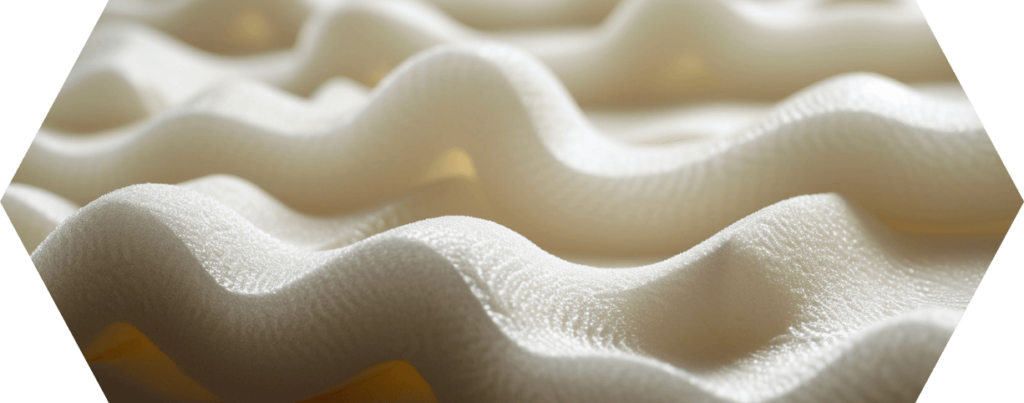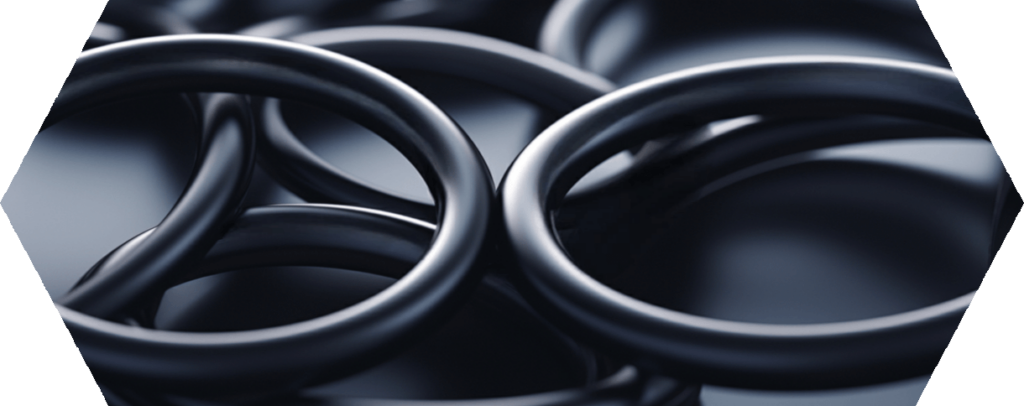CR (NEOPREN)
CR: Everything you need to know
In today’s world, CR (chloroprene rubber) and neoprene have become indispensable. These materials can be found in a wide range of products, from the automotive industry to fashion.
But what exactly are CR and neoprene? Why have they established themselves as the materials of choice in so many different industries?
CR, or chloroprene rubber, is a synthetic rubber that was first developed in the 1930s.
It is characterized by a number of properties that make it attractive for various industrial applications, such as its resistance to oil and petrol as well as its weather resistance.
Neoprene, a trade name for CR, quickly became popular as a material for waterproof clothing, especially in sportswear and equipment.
This blog post will give a deep insight into the world of CR and neoprene. We will explore the history, chemical properties, various applications, as well as the advantages and disadvantages of these versatile materials.
Our aim is to create a comprehensive understanding of why CR and neoprene are so prevalent and how they influence our modern world.
| Property/category | Chloroprene rubber (CR) | neoprene |
|---|---|---|
| Chemical base | Polymerized chloroprene | Trade name for CR |
| Year of discovery | 1930 | 1931 (commercial use as neoprene) |
| Main applications | Seals, hoses, insulation | Water sports clothing, fashion, insulation |
| Temperature range | -40°C to +120°C | -40°C to +120°C |
| Stretchability | High, retains shape when stretched | Can stretch up to 600% |
| Resistance | Chemicals, oils, weather, ageing | Chemicals, oils, weather, ageing |
| Environmental impact | Recycling challenges, petroleum-based | Similar to CR, research into more environmentally friendly alternatives |
| Innovation potential | More sustainable production, improved properties | Developments in environmentally friendly production (e.g. limestone neoprene) |
REQUEST O-RINGS QUICKLY AND EASILY?
Almost any dimension available
Offer received in record time
No minimum order quantities or minimum item values
One contact for all concerns
#1 What is CR (chloroprene rubber)?
CR, also known as chloroprene rubber, is a synthetic rubber that ushered in a revolution in materials science in the 1930s.
The development of neoprene, a trade name for CR, by the DuPont company marked a significant advance in the world of polymers and elastomers.
Facts about the story:
- Discovery: CR was discovered in 1930 by Wallace Carothers, a chemist at DuPont.
- Commercialization: DuPont began commercial production of neoprene in 1931, making it one of the first successful synthetic rubbers.
Chemical properties of CR
CR is a polymer formed by the polymerization of chloroprene. It is characterized by several key properties that distinguish it from other elastomers:
- Resistance to chemicals: CR is resistant to oils, greases and many other chemicals.
- Temperature resistance: It retains its properties over a wide temperature range.
- Resistance to ageing: CR is particularly resistant to weathering and ozone.
Variants and shapes of neoprene
Neoprene is available in different variants and shapes, making it suitable for different applications:
- Solid neoprene rubber: Used for seals and hoses.
- Foam neoprene: Known for its use in insulating clothing and mats.
- Latex neoprene: Used in medical gloves and similar products.

#2 Applications of CR and neoprene in the industry
Neoprene in the clothing industry
Neoprene has established itself as a versatile material in the clothing industry, particularly in the manufacture of sports and outdoor clothing.
Important application examples:
- Water sports clothing: Wetsuits for diving, surfing and other water sports.
- Fashionable garments: Neoprene is also valued in high fashion for its structuring and shaping quality.
Advantages of neoprene in fashion:
- Insulation: Provides warmth and protection in cold and damp environments.
- Flexibility: Allows freedom of movement, important for sportswear.
- Aesthetics: Modern, structured look that is popular with designers.
CR in the automotive industry
CR plays an important role in the automotive industry, mainly due to its durability and longevity.
CR areas of application:
- Seals and hoses: Prevent the penetration of liquids and gases into sensitive areas.
- Insulation: Electrical insulation in cables and as vibration protection.
Contribution to vehicle safety:
- Resistance: Protects against extreme temperatures and chemicals.
- Durability: Increases the service life of components, reduces maintenance costs.
Other industrial applications
CR and neoprene can also be found in many other industries that benefit from their unique properties.
Examples of diverse applications:
- Construction industry: Use in glazing, sealing and sound insulation.
- Electronics: Protection of cables and electronic components.

#3 Advantages and disadvantages of CR in the application
CR and neoprene offer numerous advantages that make them attractive for various applications.
Main advantages:
- Chemical resistance: Both materials are resistant to oils, chemicals and weathering.
- Flexibility and elasticity: They remain flexible and elastic even at different temperatures.
- Durability: CR and neoprene are known for their durability and resistance to ageing.
Possible applications in figures:
- Temperature range: They can be used in a temperature range from -40°C to +120°C.
- Stretchability: Neoprene can stretch by up to 600% of its original size while retaining its shape.
Restrictions and challenges
Despite their versatility, there are also disadvantages and challenges when using CR and neoprene.
Important restrictions:
- Environmental impact: The production of CR and neoprene can be harmful to the environment, particularly through the use of petroleum products and chemicals.
- Costs: High-quality neoprene can be expensive to produce.
Sustainability aspects:
- Recycling: The reuse and recycling of neoprene products are complex and often costly processes.
- Alternative materials: Efforts are being made to develop more environmentally friendly alternatives to CR and neoprene.
| Product category | Applications of CR | Advantages of using CR |
|---|---|---|
| Automotive industry | Seals, hoses, belts, insulation | High chemical resistance, long service life, good thermal and weather resistance, protects against ozone and ageing. |
| Building industry | Glazing seals, sound insulation, floor coverings | Resistant to weathering, excellent sealing properties, sound-absorbing. |
| Clothing | Diving suits, surfing suits, protective gloves | Waterproof, insulating, flexible, offers protection against environmental influences and mechanical stress. |
| Electronics | Cable sheathing, insulating materials | Electrical insulation, protection against moisture and mechanical influences, heat-resistant. |
| Sports equipment | Mats, joint protectors, shoe soles | Shock-absorbing, durable, flexible, comfortable in different weather conditions. |
| Medical devices | Orthopaedic supports, medical tubing | Hypoallergenic, flexible, hard-wearing, good chemical resistance to drugs and body fluids. |

#4 Innovation potential in CR and neoprene
The future of CR and neoprene looks promising, with continuous research and development aimed at further improving their properties and applications.
Future developments:
- More environmentally friendly manufacturing processes: Research is focusing on more sustainable production methods for CR and neoprene.
- Improved properties: Innovations in composition could lead to even more durable and versatile forms of neoprene.
Case Study:
- Green Neoprene project: Some companies are working on developing neoprene made from limestone instead of petroleum, which could significantly reduce the environmental impact.
Potential challenges and opportunities
With this development come challenges and opportunities that will shape the future of CR and neoprene.
Challenges:
- Environmental and health concerns: The need to develop more environmentally friendly and healthier materials.
- Economic factors: The balance between costs, performance and environmental compatibility.
Opportunities:
- Technological progress: The development of new technologies could lead to innovative applications for CR and neoprene.
- Market expansion: growing demand

#5 Use of CR in the O-ring industry
Chloroprene rubber (CR), better known under the trade name neoprene, plays an important role in the O-ring industry.
O-rings are simple but essential components in many mechanical systems where they are used as sealing elements.
The use of CR in the manufacture of O-rings offers a number of advantages that make them suitable for various industrial applications.
Key properties of CR O-rings
Chemical resistance: CR O-rings offer excellent resistance to a wide range of chemicals, including oils, grease and some acids. This property makes them ideal for applications in the chemical, automotive and manufacturing industries.
Temperature resistance: CR remains stable and flexible even at temperatures from -40°C to +120°C. This wide temperature tolerance allows CR O-rings to be used in environments that are exposed to extreme temperature fluctuations.
Weather and ozone resistance: CR is highly resistant to weathering and ozone, which contributes to the longevity of O-rings in outdoor applications.
Applications of CR O-rings
- Automotive industry: Use in fuel systems, air conditioning systems and oil circuits.
- Mechanical engineering: Seals in hydraulic and pneumatic systems.
- Electronics and electrical engineering: Insulating seals in electrical enclosures.
Challenges and innovations
Although CR O-rings offer many advantages, there are challenges, particularly in the area of environmental compatibility.
The production of CR is based on petroleum, which raises environmental concerns. Research and developments are aimed at finding more environmentally friendly alternatives without compromising the performance of the O-rings.

#6 FAQ section: CR
Finally, some answers to frequently asked questions.
#6.1 What are the main differences between CR and neoprene?
CR (chloroprene rubber) is the chemical name of the material, while neoprene is a trade name for CR introduced by DuPont.
Both basically refer to the same material, although neoprene is often used in the context of specific products such as diving suits or insulation materials.
#6.2 For which applications is neoprene typically used?
Neoprene is often used in the clothing industry for water sports clothing such as diving suits and surfing suits.
It is also used in the fashion industry, in the automotive industry for seals and hoses and in the electronics industry for cable protection and insulation.
#6.3 Why is CR used in the automotive industry?
CR is valued in the automotive industry for its excellent chemical resistance, durability and resistance to extreme temperatures and weather conditions.
These properties make it ideal for the production of seals, hoses and insulating materials that contribute to the safety and durability of vehicles.
#6.4 Are there any environmental concerns regarding the production and use of CR and neoprene?
Yes, the production of CR and neoprene is mainly based on petroleum and involves various chemicals, which raises environmental concerns. There are also challenges in recycling these materials.
However, efforts are being made to develop more environmentally friendly alternatives and manufacturing processes, such as limestone-based neoprene.
“I am convinced that we should share our knowledge with the world. I hope I have been able to answer all your questions. If you have any further questions, please feel free to contact us at any time. We will be happy to help you.”

Lord of the O-rings
Author of the Sealing Academy
